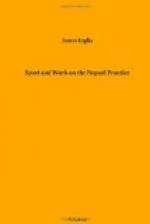About eight in the morning my bearer woke me out of a deep sleep, with the news that there was a gaerha, that is, a rhinoceros, close to the factory. We had some days previously heard it rumoured that there were two rhinoceroses in the Battabarree jungles, so I at once roused my soundly-sleeping friends. Swallowing a hasty morsel of toast and a cup of coffee, we mounted our ponies, sent our guns on ahead, and rode off for the village where the rhinoceros was reported. As we rode hurriedly along we could see natives running in the same direction as ourselves, and one of my men came up panting and breathless to confirm the news about the rhinoceros, with the unwelcome addition that Premnarain Singh, a young neighbouring Zemindar, had gone in pursuit of it with his elephant and guns. We hurried on, and just then heard the distant report of a shot, followed quickly by two more. We tried to take a short cut across country through some rice-fields, but our ponies sank in the boggy ground, and we had to retrace our way to the path.
By the time we got to the village we found an excited crowd of over a thousand natives, dancing and gesticulating round the prostrate carcase of the rhinoceros. The Baboo and his party had found the poor brute firmly imbedded in a quicksand. With organised effort they might have secured the prize alive, and could have sold him in Calcutta for at least a thousand rupees, but they were too excited, and blazed away three shots into the helpless beast. ‘Many hands make light work,’ so the crowd soon had the dead animal extricated, rolled him into the creek, and floated him down to the village, where we found them already beginning to hack and hew the flesh, completely spoiling the skin, and properly completing the butchery. We were terribly vexed that we were too late, but endeavoured to stop the stupid destruction that was going on. The body measured eleven feet three inches from the snout to the tail, and stood six feet nine. The horn was six and a half inches long, and the girth a little over ten feet. We put the best face on the matter, congratulated the Baboo with very bad grace, and asked him to get the skin cut up properly.
Cut in strips from the under part of the ribs and along the belly, the skin makes magnificent riding-whips. The bosses on the shoulder and sides are made into shields by the natives, elaborately ornamented and much prized. The horn, however, is the most coveted acquisition. It is believed to have peculiar virtues, and is popularly supposed by its mere presence in a house to mitigate the pains of maternity. A rhinoceros horn is often handed down from generation to generation as a heirloom, and when a birth is about to take place the anxious husband often gets a loan of the precious treasure, after which he has no fears for the safe issue of the labour.




